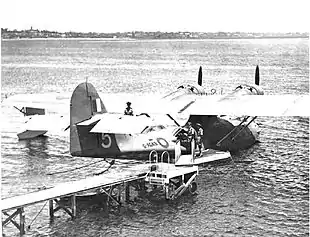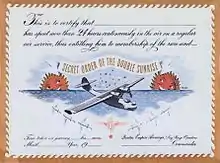The Double Sunrise
The Double Sunrise service was formed in 1943 to re-establish the Australia–England air link that had been cut due to the fall of Singapore in 1942. The service initially operated from its base in Nedlands, Western Australia near Perth,[1] to the Royal Air Force base at Lake Koggala near Galle in Ceylon (now Sri Lanka). It was later extended to Karachi in India (now part of Pakistan), which was the terminus for the BOAC service from England. The name of the service was derived from the crew and passengers observing two sunrises on each flight.

History
In 1943, Royal Australian Air Force personnel were seconded to operate Consolidated PBY Catalina seaplane aircraft under the banner of Qantas. The plan called for flights between Crawley, Western Australia, and RAF Base Koggala in southern Ceylon. The flights were (then) the longest non-stop air route of any airline, over 3,500 nautical miles (6,480 km, 4,020 mi) across the Indian Ocean. Navigating without the aid of radio, the crews relied solely on rudimentary navigation by compass and stars during the trip.[2][3] Five aircraft obtained under Lend-Lease were supplied by the British Air Ministry, and were named after stars used for navigation en route: Rigel Star, Spica Star, Altair Star, Vega Star and Antares Star. The first flight took place on 29 July 1943.[4]
Taking between 27 and 33 hours, with departure timed so that the flight crossed Japanese occupied territory during darkness, the crews would observe the sunrise twice, which led to the service being known as "The Double Sunrise".[5] The flight route flown was along the coast from Crawley to Exmouth then setting out towards Cocos (Keeling) Island or Christmas Island (though neither was actually sighted during the flight1) and onto Galle, a journey of approximately 3,580 nautical miles (6,630 km; 4,120 mi). After the success of the initial flights, it was decided to run a weekly service, with some services flying over Rottnest Island and then taking a direct line to Galle. As part of the Australia-England air route there was a surface component from Galle to Karachi that added considerable time to the service. This was later replaced by the Double Sunrise service, with Karachi to England flown by BOAC.[6] Air crews would change in Galle taking the next plane in either direction minimizing the time taken to complete the journey.[7]1
Though stripped of all non-essential equipment, including de-icing equipment and insulation, the average takeoff weight was 35,100 to 35,300 lb (15,900 to 16,000 kg) (maximum takeoff weight for a PBY Catalina was 35,400 lb (16,100 kg)); this included 1,988 imperial gallons (9,040 L) of fuel, which gave the Catalina a range of 3,600 nautical miles (6,700 km; 4,100 mi). The service made 271 crossings, delivered over 10,000 lb (4,500 kg) of mail and carried 860 passengers, including among them British MP Edith Summerskill and the journalist Keith Murdoch.2[7][8] Due to the weight of the auxiliary fuel, an average flight carried only 3 passengers and 152 pounds (69 kg) of essential mail.[4]
Starting in June 1944, Qantas augmented the Catalinas with the first of two converted Consolidated Liberator bombers. The Liberators flew a shorter 3,077 mi (4,952 km) over-water route from Learmonth to an airfield northeast of Colombo, but they could make the journey in 17 hours with 5,500 pounds (2,500 kg) of payload, whereas the Catalinas usually required at least 27 hours and their payload was limited to only 1,000 pounds (450 kg). The route was named Kangaroo Service and marked the first time that Qantas's now-famous Kangaroo logo was used; passengers received a certificate proclaiming them as members of The Order of the Longest Hop.[9]
In June 1945, Avro Lancastrians were introduced on the England–Australia service, and the Liberators and Catalinas were soon shifted to other Qantas routes.[9] Double Sunrise service ended on 18 July 1945.[4] After the war, in accordance with the terms of the Lend-Lease agreement,[4] the five modified Catalinas that had flown The Double Sunrise service were scuttled.[2]
The Double Sunrise flights remain the longest (in terms of airtime) commercial flights in history.[10][11]
Secret Order of the Double Sunrise

The Secret Order of the Double Sunrise was an illustrated certificate given to passengers aboard the flying boats of the Australia–England air link, to attest they had been airborne for more than 24 hours.[5][12]
Documentary film
In 2013, a documentary film[13] was made to celebrate the 70th anniversary of the Double Sunrise flights. The film features 93-year-old Rex Senior who is the last remaining pilot. The film was released on Qantas Inflight globally and on DVD.[14][15]
References
- Note that some references to the flying boat service use Pelican Point, and Crawley as the location, rather than Nedlands – see http://pandora.nla.gov.au/pan/13710/20020921-0000/home.st.net.au/_dunn/ozatwar/mucrawley.htm
- Catanzaro, Joseph (28 December 2010). "Heroic squadron loses last pilot". The West Australia. Retrieved 28 December 2010.
- "World'S Longest Air Hop To Be "Kangaroo Service"". The Argus. Melbourne: National Library of Australia. 7 August 1944. p. 2. Retrieved 29 December 2010.
- "The Catalinas". Qantas.com. Qantas. Retrieved 7 April 2018.
- "Film Of Perth-Ceylon Air Service". The West Australian. Perth: National Library of Australia. 23 December 1948. p. 10 Edition: 3rd Edition. Retrieved 29 December 2010.
- "Indian Ocean Air Hop". The Sydney Morning Herald. National Library of Australia. 5 August 1944. p. 4. Retrieved 29 December 2010.
- Senior, Rex. "Double sunrise service" (PDF). Retrieved 28 December 2010.
- "Australian Newspaper Proprietor Says England Is Now Thinking Far Ahead". Army News. Darwin, NT: National Library of Australia. 26 July 1944. p. 4. Retrieved 29 December 2010.
- "Thirty Years of Qantas". Flight. Vol. LVIII no. 2182. London. 16 November 1950. Retrieved 6 April 2018.
- Agency, Digital Transformation. "Flying boats in the Second World War, 1939–45 | australia.gov.au". www.australia.gov.au. Retrieved 2017-02-20.
- Defence, Australian Government, Department of. "RAAF Museum: Royal Australian Air Force". www.airforce.gov.au. Retrieved 2017-02-20.
- Frank Stanley Stuart, Henri Charles Biard. Modern Air Transport. J. Long Ltd. 1946, page 95.
- http://www.catalinadoco.com CatalinaDoco.com
- McCormack, Chris (15 July 2013). "war-film-tribute-to-secret-flight". The Bayside Bulletin. Retrieved 15 July 2013.
Roger Thiedeman (27 February 2007). "Koggala, Catalinas, and the double sunrise". The Sunday Times. Colombo, Sri Lanka. Retrieved 15 February 2009.
Roger Thiedeman: http://serendib.btoptions.lk/article.php?issue=103&id=2441
Notes
- Rex Senior was the 1st Officer & Navigator on the first service, he was also on the crew for many of the subsequent flights, serving with the unit until march 1944.
- 1.^1 Flight information is from Rex Senior's recollections there is no reference to official documentation for verification.
Further reading
- Eames, Jim (2017). Courage in the Skies: The untold story of Qantas, its brave men and women and their extraordinary role in World War II. Sydney: Allen & Unwin. ISBN 9781760293932.
External links
- Official Documentary Film Website The Double Sunrise Flights Official Film Website
- Double Sunrise flight by Rex Clifton Senior(1st Officer & navigator on the first official flight) {{Dead link}}
- Qantas Web site
- Australian War memorial interview — Interview with Captain R. J. "Bert" Ritchie AO CBE (By the seats of their pants) 27 October 1987; 58 minutes